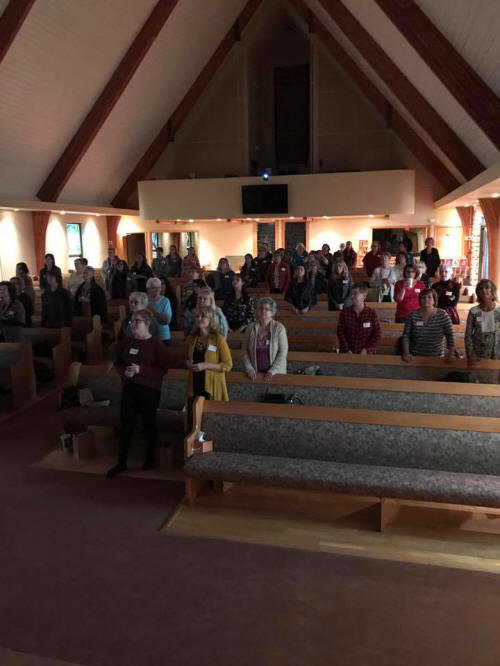|
Builder: Reuter Organ Co., Op. 829, 1948. Manuals: 2 Ranks: 6 Action: Electro-pneumatic Notes: 1861 brought about the beginning of the War Between The States which greatly affected the churches and their mission. The General Convention was split because of the war, and became the Southern Baptist Convention and the Northern Baptist Convention. On March 1, 1861, Congress passed an act for setting up the Dakota Territory; in November of 1889, South Dakota became recognized as a state. As people continued to forge westward, the convention sent other missionaries who were called of God to minister to those hardy pioneers. In 1901, the South Dakota Convention voted that we “undertake to furnish one colporter wagon and outfit to be employed within the state of South Dakota, and that pastors be encouraged to solicit subscriptions of one dollar or more and that the Sunday Schools be requested to devote to this object their regular collection on the last Sunday in October, 1901. $729.45 was brought in. The entire cost of the wagon, plus the horses and harness, cooking utensils, mattress, pillows, sheets, blankets, and a baby organ was $603.40. Thus a surplus of $116.05 was applied on the salary of the district missionary to be employed by the convention. The missionary traveled around the state in the colporter wagon ministering to those folks in isolated places on the prairie. This wagon has been restored by Rev. Sandy Akers, the pastor at Vermillion, and is on display there. Later, colporter railroad cars were established which hooked onto trains which were going through the territory. The cars were furnished with a small chapel and organ as well as living quarters for the missionary. When the train stopped at a town, the car would be sidetracked so that the missionary could stay there for a time, conducting services and ministering to the needs of the people. There are colporter cars on display at Madison, SD and at the Green Lake Assembly grounds. The First Baptist Church was founded on June 16, 1889, the same year that South Dakota was granted statehood. The first church met above a saloon. Dr. Shahafelt, appointed by the Northern Baptist Home Mission Society as a missionary to the brand-new state, came to the Hills in 1889. He said of his experiences, “Not only is there gold in the Hills, but Baptists are scattered everywhere; and in nearly every locality they are scattered like sheep not having a shepherd.” There were ten charter members of the church, among them Jennie Brennan, Helen’s grandmother, who also played the organ for the little group. On July 1, 1889, Rev. G.S. Clevenger became pastor and continued with them six years. Rev. Clevenger was a product of western New York and of Denison University. He wrote, “We were determined to lift up the standard of Christ in Godless Dakota.” He had pastored churches in Brookings and Vermillion and he described those towns “where stores were open and business was conducted on the Sabbath about as on any other day. This worldliness on the part of Christian people made progress in the churches for a time very slow. When we came to the Black Hills, we again plunged into the wilderness. We found a little band of ten persons organized into a Baptist Church. They did not possess even a singing book.” After six years, Rev. Clevenger closed his work in Rapid City; the church had grown to 73 persons. The congregation purchased a little church on Columbus Street (it’s now on the corner of 5th and St. Patrick.) They later purchased a lot on Kansas City Street, “but all they had was a basement for a while,” Helen Wrede relates, “that’s all the money they could raise.” The building was completed and the parsonage was attached as a part of the church building. The pastor from 1943-1948, said that he remembered living with his family in the parsonage where the pipes of the organ in the sanctuary were just on the other side of the wall of the family’s bedroom. He recalled one time when he was conducting a wedding and his little child peeked his head out around the front of the sanctuary. He had escaped from his mother and wandered from his home into the church proper. In 1957, land was bought on the very edge of town for the purpose of constructing a new church building. The building which is used at the present time was completed and dedicated in 1958. Information from church website and from Chris Leaver of Reuter Organ Co. Also, Organ Historical Society as of 2020. Editor note: Information from Audrey Fenner, 8/2020, this organ was never in this church, and there has never been a pipe organ in this building. Revised information from the choir director via Audrey, 09/08/2020 -- There is a pipe organ at First Baptist, but there is no common knowledge of anyone ever playing it. |
 |
 |
|
|
GREAT 16' Diapason tc 8' Open Diapason 8' Gedeckt 8' Salicional 8' Voix Celeste 8' Dulciana 4' Octave 4' Flute 4' Violina 4' Dulcet 2' Flachflute 16' Contra Oboe tc 8' Oboe 4' Clarion Chimes SWELL 16' Bourdon tc 16' Contra Viole tc 8' Diapason 8' Gedeckt 8' Salicional 8' Voix Celeste 8' Dulciana 4' Flute d'Amour 4' Violina 4' Voix Celeste 2.2/3' Nasard 2' Flautino 8' Orchestral Horn (synth) 8' Oboe PEDAL 16' Bourdon 8' Diapason 8' Bass Flute 8' Cello 8' Dolce 4' Octave 8' Oboe ANALYSIS 8' Open Diapason 73 8' Gedeckt 85/Bourdon 12 8' Salicional 73 8' Voix Celeste tc 61 8' Dulciana 8' Oboe |
|